This guide will explore diverse full-sun ground cover options, featuring detailed insights into their unique characteristics, advantages, and gardening tips.
Creeping Thyme (Thymus serpyllum)
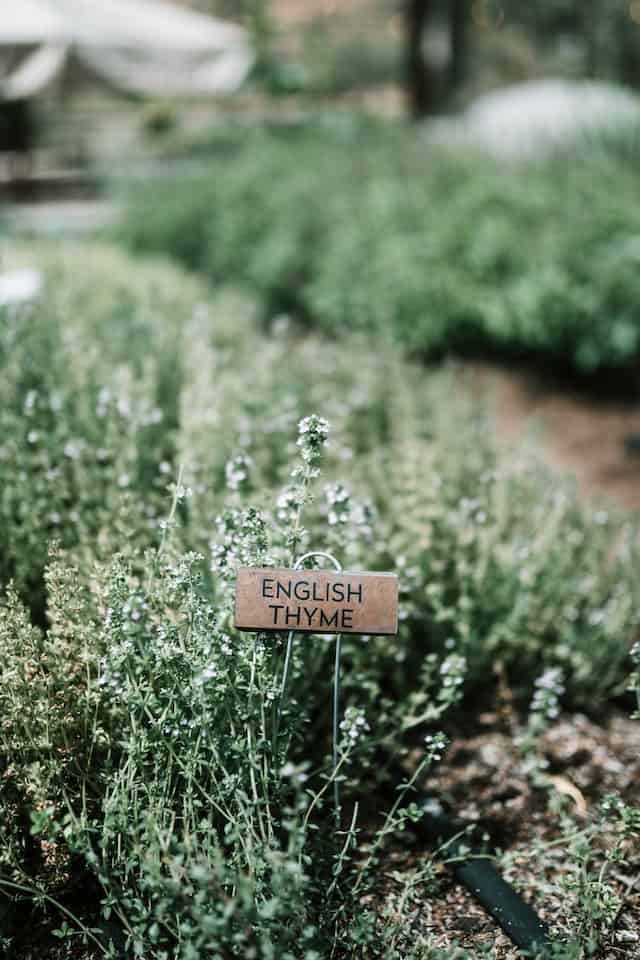
Creeping Thyme is a perennial herb that offers not only a beautiful facade but also practical advantages. It thrives in full sun and well-drained soil, making it a great candidate for rock gardens, borders, and pathways. With its tiny green leaves and vibrant purple flowers, this plant can transform ordinary areas into vibrant spaces. The leaves emit a delightful fragrance, and when walked upon, they release an aromatic scent that lingers in the air.
Noteworthy is its resilience; once established, Creeping Thyme is highly drought-resistant, a crucial attribute for those hailing from dry regions. Its low-growing nature means it grows well in crevices and between stones, allowing it to be a choice for those looking to fill difficult spaces in their landscape. Beyond its ornamental value, it can serve as an edible herb, enhancing culinary dishes. Additionally, Creeping Thyme is loved by pollinators, attracting bees and butterflies to your garden, which supports local biodiversity.
In terms of care, Creeping Thyme is relatively low-maintenance. Regular trimming after flowering can help maintain its shape and promote bushier growth. Planting it in well-drained soil with adequate sunlight will yield the best results, and its ability to tolerate light foot traffic makes it a versatile option.
Sedum (Sedum spp.)
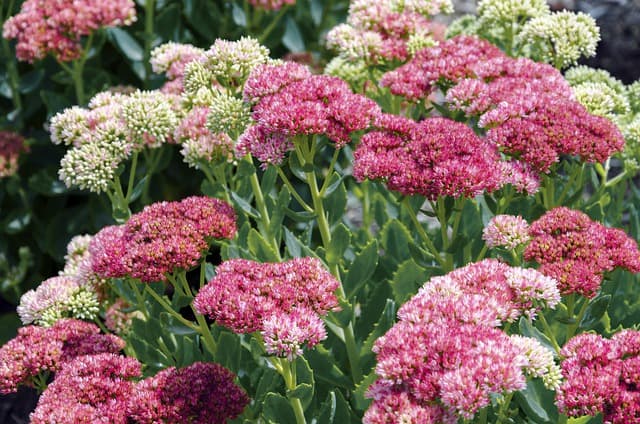
Sedum is a genus that encompasses a diverse range of succulent plants, each with its striking attributes. Known as stonecrop, these hardy plants excel in full sun and grow well in low-nutrient soils, which makes them a reliable option for gardeners seeking resilience. Sedum varieties vary from upright to sprawling forms, providing a multitude of options for ground cover in different settings, including rockeries, containers, and borders.
The fleshy leaves of Sedum store water, making them ideal for areas with poor moisture. These plants are particularly advantageous for gardeners practicing xeriscaping or for those in arid climates. During the summer months, Sedum becomes a splash of color as it blooms with clusters of tiny flowers, ranging from soft yellows to vibrant reds and pinks, which are particularly attractive to pollinators like bees and butterflies.
Sedum is remarkably easy to propagate, making it an economical and enjoyable choice for enthusiastic gardeners. Division, cuttings, or even seed propagation can easily increase your stock. Maintenance is minimal; they thrive on neglect, just requiring periodic pruning to remove any dead foliage. Their ability to resist pests and diseases further solidifies their status as a garden favorite.
Ice Plant (Delosperma cooperi)
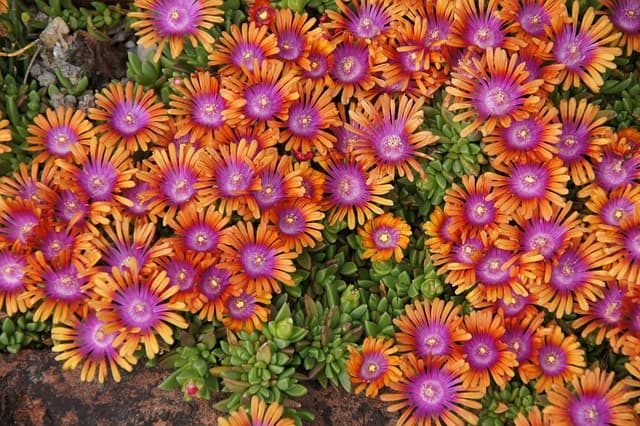
Ice Plant is a captivating succulent ground cover that is perfect for sunny landscapes. Its fleshy leaves, often deep green or tinged with purple, form a dense mat that is visually appealing in both summer and winter. The star of the show, however, lies in its vibrant flowers. From late spring to late summer, Ice Plant bursts into life with bright yellow or pink blooms that shimmer like jewels in the sunlight.
This drought-tolerant plant thrives in sandy or rocky soils, characterized by excellent drainage, which helps prevent root rot. Ice Plant’s ability to withstand extreme conditions makes it an excellent choice for coastal gardens, where strong winds and salt exposure are considerations. Its dense growth habit also means that it can effectively suppress weeds, creating a more carefree gardening experience.
Ice Plant is incredibly low-maintenance; it requires regular watering until established, then little to no water thereafter. The vibrant flowers not only serve as an ornamental feature but also attract bees and butterflies, enriching the garden’s ecosystem. Deadheading spent blooms can promote prolonged flowering, providing continuous color throughout the growing season.
Creeping Phlox (Phlox subulata)
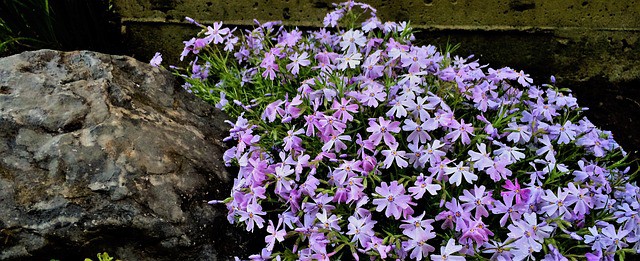
Creeping Phlox is a perennial favorite that dazzles in the spring with a spectacular floral display. This charming ground cover produces a sea of star-shaped flowers in various colors, including pink, white, blue, and purple. With its low-growing habit, Creeping Phlox makes an excellent choice for borders, rock gardens, or cascading over walls.
Beyond its stunning flowers, Creeping Phlox is known for its hardiness. It thrives in full sun and tolerates a range of soil types, although well-draining soil is preferred. Once established, this plant requires minimal care, making it a go-to for busy gardeners. Moreover, Creeping Phlox’s adaptability to different conditions means it can thrive in various garden styles, from cottage gardens to modern landscapes.
This ground cover effectively suppresses weeds, thanks to its dense foliage that fills in quickly. It also brings a vibrant nectar source for pollinators, attracting butterflies, bees, and hummingbirds during its blooming period. Regular watering during drought can help it retain vigor, but overall, Creeping Phlox is a resilient and attractive addition to any full-sun garden.
Creeping Jenny (Lysimachia nummularia)
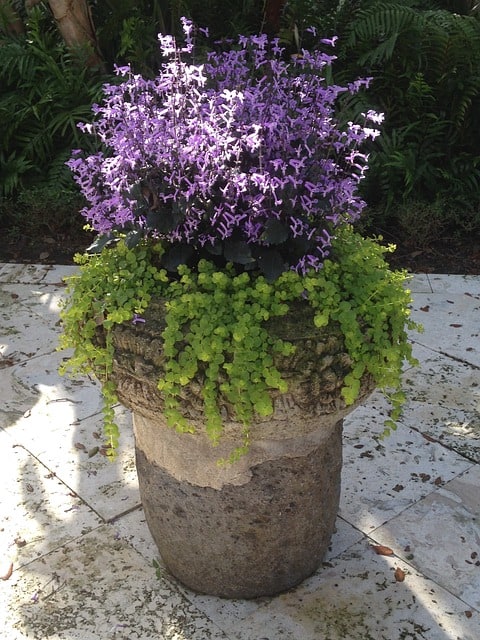
Creeping Jenny delivers a vibrant pop of color to gardens with its striking golden-yellow foliage in spring, transitioning to shades of green in summer. This perennial ground cover flourishes in full sun and is known for its rapid growth and spreading habit. It is highly effective in filling bare spots, covering slopes, and preventing soil erosion due to its dense root system.
A standout feature of Creeping Jenny is its versatility; while it thrives in sun, it can also tolerate partial shade, providing flexibility for gardeners. The charming, cup-shaped yellow flowers that appear in late spring add an extra touch of beauty to this already attractive plant. Additionally, its ability to adapt to various soil conditions makes it a suitable option for most gardens.
Creeping Jenny requires little maintenance beyond occasional trimming to control its spread. Its rich texture and luminous color make it an excellent choice for pairing with other perennials, creating visual contrasts and enhancing garden depth. It is particularly effective when combined with darker foliage plants, which highlight its golden hue. Overall, Creeping Jenny stands as a versatile ground cover choice with unique seasonal appeal.
Lamb’s Ear (Stachys byzantina)
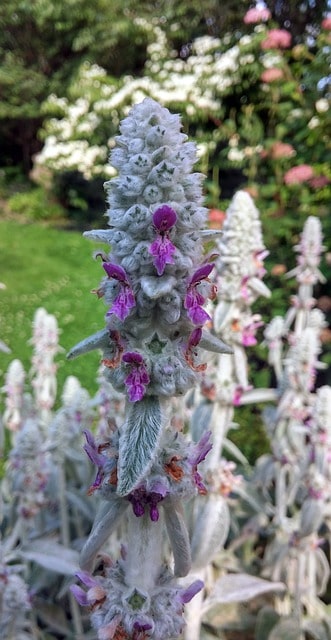
Lamb’s Ear is distinct with its soft, fuzzy leaves, which resemble the ears of a lamb and offer a unique textural dimension to gardens. This perennial ground cover thrives in full sun, forming a thick mat of silvery-green leaves that can tolerate foot traffic, making it a fabulous option for pathways and borders.
In late spring and early summer, Lamb’s Ear produces elegant spikes of purple flowers that rise above the foliage, supplying a striking contrast to the leaves. Although primarily appreciated for its foliage, the flowers attract bees and other pollinators, thus enhancing biodiversity in the garden.
Beyond its ornamental value, Lamb’s Ear is relatively low-maintenance, requiring minimal care once established. It flourishes in well-drained soil and is drought-resistant, making it ideal for xeriscaping. Regular pruning after flowering encourages bushier growth and can keep the plant looking its best throughout the growing season. Its adorable characteristics and resiliency make Lamb’s Ear a beloved choice for any full-sun landscape.
Basket of Gold (Aurinia saxatilis)

Basket of Gold, with its bright yellow blooms, can create a vibrant ground cover that heralds the arrival of spring. This perennial thrives in full sun and well-drained soil, and is especially well-suited for rocky or sandy areas. Its dense growth habit makes it excellent for suppressing weeds, thus promoting easier garden maintenance.
From late spring to early summer, Basket of Gold blooms profusely with clusters of yellow flowers, which not only brighten up the landscape but also attract pollinators like bees and butterflies. This cheerful ground cover can create a stunning visual effect when planted in masses, and it’s well-suited for planting along pathways or in perennial gardens.
This plant is drought-tolerant, making it a perfect candidate for water-wise gardening. After flowering, deadheading the spent blooms can promote healthier growth and further flowering. In terms of care, it thrives in poor soils, and regular trimming helps maintain its shape and encourages new growth. Basket of Gold stands out for its bright color and ability to thrive in challenging conditions, ensuring a flourishing landscape.
Blue Fescue (Festuca glauca)
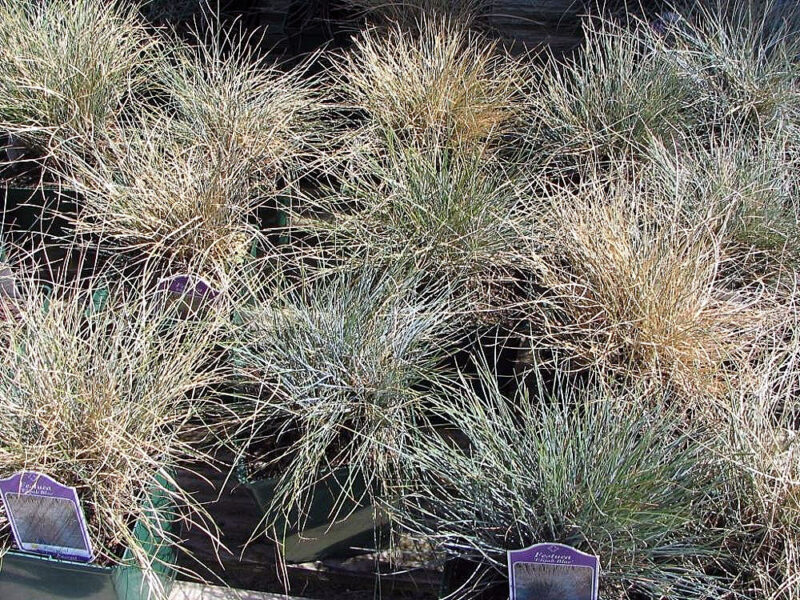
Blue Fescue is a stunning ornamental grass that adds cool green-blue hues to sunny gardens. Its fine-textured blades create a lovely, soft appearance, ideal for borders or mass planting. This tidy, clump-forming grass thrives in full sun and well-drained soil, displaying a vigorous growth habit without being invasive.
One of the most attractive features of Blue Fescue is its unique coloration. The blue-green foliage adds a wonderful contrast to other plants, and during summer, delicate flower spikes can emerge above the foliage, enhancing the grassy texture. This drought-tolerant plant is perfect for xeriscaped gardens, as it requires very little supplemental watering once established.
Blue Fescue typically requires minimal maintenance; it can tolerate poor soil conditions and does not require frequent fertilizing. To maintain a tidy appearance, dividing the clumps every few years can promote healthy growth and vigor. Its low profile and striking color make Blue Fescue an excellent choice for gardeners seeking to enrich their gardens with texture and unique visual appeal.
Mazus (Mazus reptans)
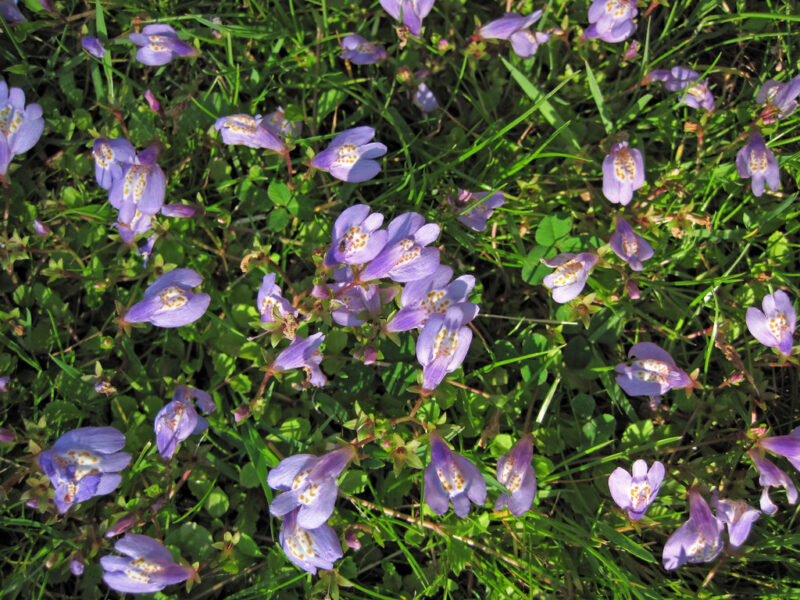
Mazus, known for its creeping nature, is a charming perennial that thrives in sunny areas and is suitable for tolerating a fair amount of foot traffic. Its shiny green foliage offers a lush appearance, while its small, tubular flowers bloom in blue or white, providing an attractive display during the late spring and summer months.
This hardy ground cover is particularly effective for filling gaps, as it spreads quickly to cover bare soil and prevent weed establishment. Mazus prefers well-drained soil, making it ideal for rock gardens, slopes, and planting between stepping stones.
In addition to its aesthetic appeal, Mazus plays an essential role in attracting pollinators to the garden. Regular watering during dry periods ensures it remains healthy and vibrant. Although Mazus can thrive in a variety of conditions, avoiding overly wet or clay-rich soils is crucial, as it may lead to root rot. Overall, Mazus is an excellent ground cover choice that provides both beauty and function in sunny gardens.
Snow-in-Summer (Cerastium tomentosum)
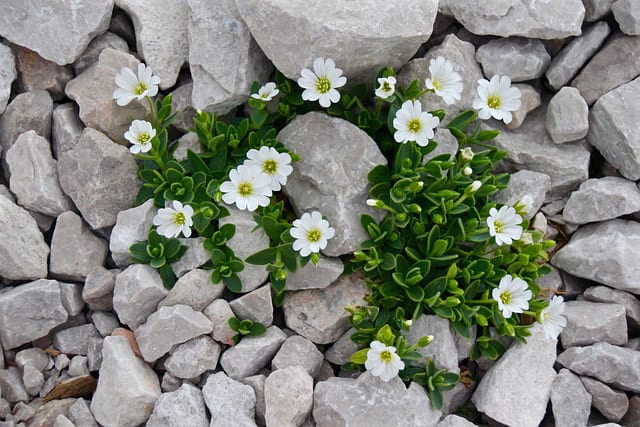
Snow-in-Summer is renowned for its stunning, frosty appearance combined with bursts of cheerful white flowers. This perennial thrives in full sun and is particularly effective in well-drained, sandy soils. During late spring to early summer, it produces abundant white, star-shaped flowers; these blooms, paired with its silvery foliage, create a striking visual effect reminiscent of fresh snow blanketing the garden.
Snow-in-Summer is especially beneficial for reducing erosion on exposed slopes thanks to its dense root system. This ground cover effectively suppresses weed growth while adding a soft texture to the overall landscape design. It’s a fantastic plant for rock gardens, pathways, and containers.
Low maintenance is one of Snow-in-Summer’s appealing qualities—once established, it requires minimal watering, making it particularly suitable for arid regions. Regular division is recommended to prevent overcrowding, and occasional trimming can help maintain its shape. Whether you’re looking to enhance a sunny hillside or add interest to a flower bed, Snow-in-Summer remains an impressive choice with seasonally captivating beauty.
Silver Carpet (Dymondia margaretae)

Silver Carpet is a unique, low-growing ground cover that thrives in the sun and shines with silvery-green foliage. This plant is incredibly drought-tolerant once established and adapts beautifully to poor, sandy soils. Its growth habit helps it to spread swiftly, filling in gaps and providing a lush carpet effect.
In late spring, Silver Carpet produces small yellow flowers that provide delightful visual interest. It’s particularly effective for creating pathways or edging around garden beds, and its resilience makes it a favored choice for coastal gardens. Its ability to withstand light foot traffic further enhances its utility in walkways and casual garden spaces.
Silver Carpet is low-maintenance, requiring only occasional watering after establishment. Regular light trimming can keep its growth in check and promote healthy new growth. The combination of its ornamental qualities and durability makes Silver Carpet a fantastic choice for gardeners looking to achieve style and function in sun-drenched landscapes.
Portulaca (Portulaca grandiflora)
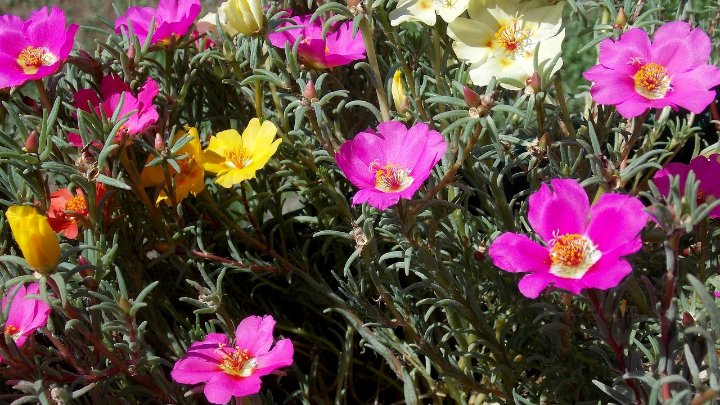
Portulaca, commonly known as moss rose, is a lovely succulent ground cover that thrives in the summer sun. With its vibrant, cup-shaped flowers in shades of yellow, pink, red, and white, it provides a dramatic splash of color in full sun gardens. Portulaca blooms during the day and closes at night, adding a dynamic visual aspect to your landscape.
This plant is well-suited for poor, well-drained soils, making it an excellent choice for rock gardens or containers where consistent moisture may not be available. Portulaca is an extremely drought-tolerant plant, requiring minimal care once established, allowing gardeners to enjoy its beauty without excessive maintenance.
In addition to its ornamental qualities, Portulaca is great at attracting pollinators like bees and butterflies, enriching your garden ecosystem. When planting, it is recommended to sow seeds or transplant young plants after the risk of frost, as Portulaca thrives in warm weather. Overall, Portulaca is a treasure for sunny spaces, offering color, durability, and minimal upkeep.
Dianthus (Dianthus spp.)
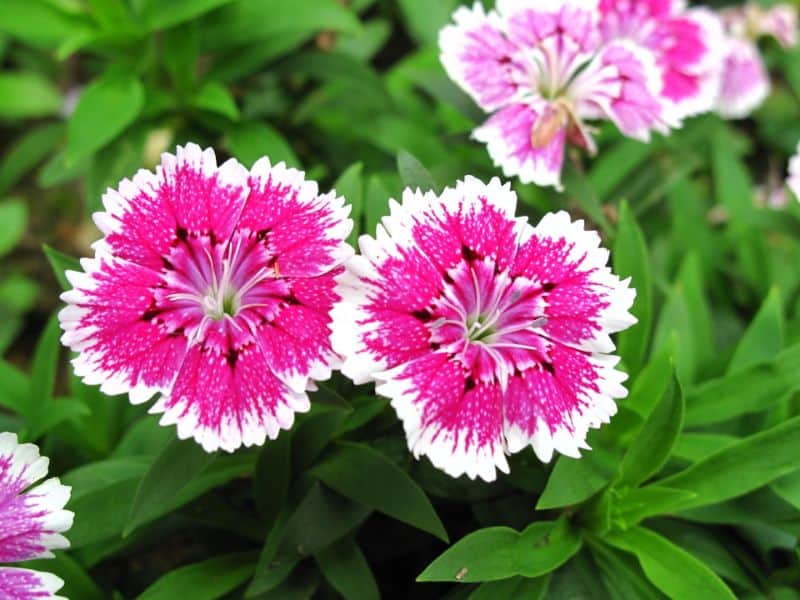
Dianthus, sometimes referred to as pinks, is a beloved perennial that encompasses a range of vibrant colors, textures, and fragrances. This low-growing plant thrives in full sun and typically produces flowers in shades of pink, red, or white. With a long blooming season from spring into summer, Dianthus adds ongoing beauty to the landscape while also attracting pollinators.
This hardy plant favors well-drained soil and can grow in a variety of garden settings, from borders to containers. It is notably tolerant of poor soil conditions, thriving where other plants may struggle. The evergreen foliage of many Dianthus varieties provides garden interest even outside the bloom season, contributing to a year-round landscape presence.
Dianthus requires minimal maintenance, with regular deadheading promoting additional blooms and enhancing the plant’s growth habit. Occasionally, dividing the clumps will promote vigor and fullness. With its delightful fragrance and robust adaptability, Dianthus remains a fundamental aspect of sunny garden designs.
Plumbago (Ceratostigma plumbaginoides)
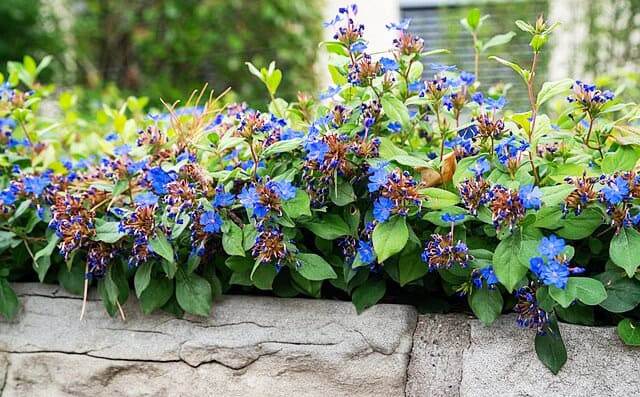
Plumbago, known for its mesmerizing blue flowers, can add a layer of color to summer landscapes. This perennial ground cover thrives in full sun and can successfully adapt to various soils, although well-drained conditions help it perform optimally. The vibrant blue flowers bloom from late summer to fall, providing a lively and refreshing contrast in the garden.
Plumbago’s sprawling nature allows it to work well as a ground cover, growing effectively between larger plants or alongside borders. Its lush green leaves are also a sight to behold, creating a beautiful backdrop for the striking flowers. Furthermore, it is drought-tolerant once established, requiring minimal intervention in the garden.
Regular pruning after flowering can encourage bushy growth and extend its aesthetic appeal. Overall, Plumbago is an exceptional option for those seeking late-season color and an effective ground cover that adds charm and vibrancy to sunny garden spaces.
Verbena (Verbena spp.)
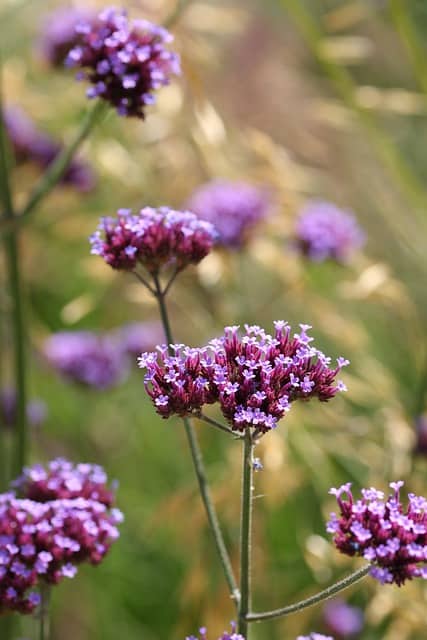
Verbena is a versatile genus that includes numerous varieties of flowering plants perfect for sunny spots. Often characterized by clusters of tiny flowers in shades of purple, pink, white, or red, Verbena blooms frequently throughout the summer, creating an unbroken display of color. Highly adaptable, it thrives in full sun and is tolerant of various soil conditions, making it a fantastic choice for diverse landscapes.
In addition to its ornamental value, Verbena also attracts numerous pollinators—essential for a healthy garden ecosystem. It can be used effectively in garden borders, hanging baskets, or as a cascading plant in containers, providing endless options for design.
Verbena is relatively low-maintenance, requiring basic watering until established and occasional deadheading to encourage new blooms. Its ability to attract butterflies and bees, combined with its vibrant flowers, makes Verbena a beloved choice for gardeners looking to enhance their sunlight-drenched spaces artfully.
Chamomile (Chamaemelum nobile)
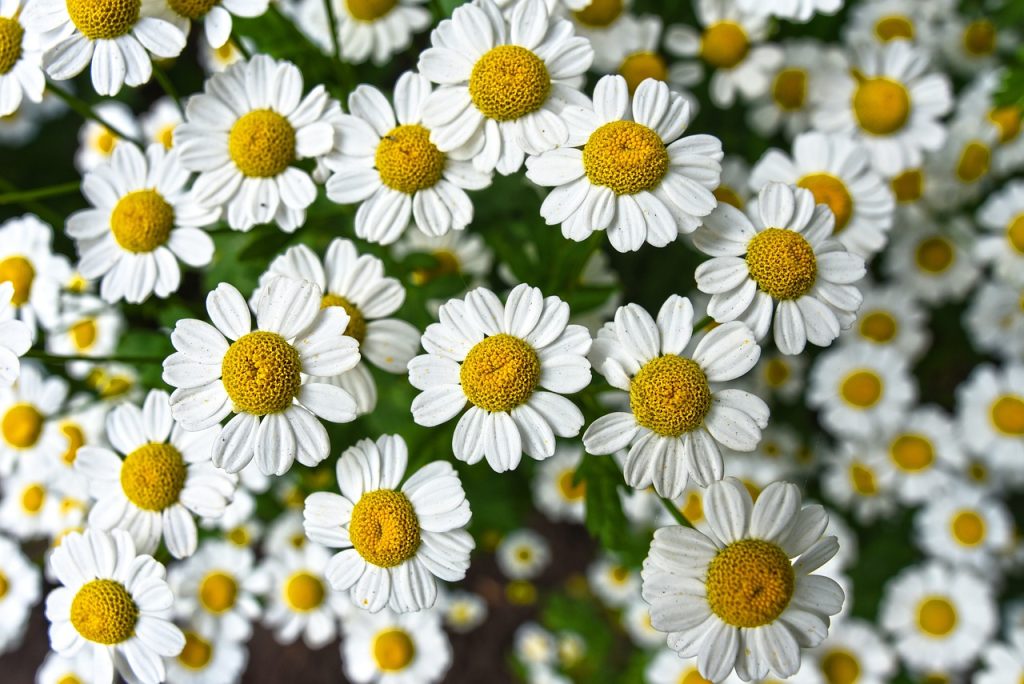
Chamomile is both a stunning addition to any sunny garden and a popular herb known for its calming properties. This perennial features dainty, feathery foliage that complements its daisy-like flowers, which produce a pleasant fragrance that can fill your garden with aromatic delight. Chamomile thrives in full sun, preferring well-drained soils where it can spread and populate easily.
Beyond its ornamental characteristics, Chamomile serves a practical purpose in the kitchen. Its blossoms are often harvested and used in teas or culinary dishes, promoting a sense of well-being. This herb can also help improve soil health by attracting beneficial insects and pollinators.
Chamomile is relatively easy to care for; regular trimming and deadheading can promote more vigorous growth and may extend the flowering season. However, it’s essential to prevent overcrowding, as this can lead to disease. With its delightful aroma, charming appearance, and versatility, Chamomile can be a unique and valuable addition to a full-sun garden.
Sweet Alyssum (Lobularia maritima)
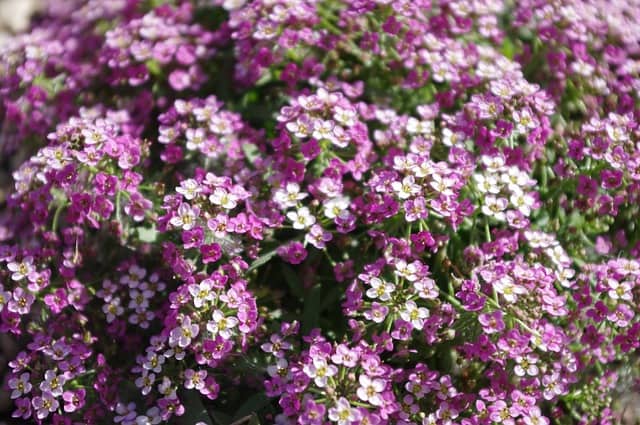
Sweet Alyssum is a charming little annual that offers a delightful fragrance and a visual treat. This low-growing plant thrives in full sun and produces clusters of small white, pink, or lavender flowers that create a sweet-scented carpet in gardens. Its ability to spread quickly and fill in bare spaces makes it an excellent choice for borders, hanging baskets, or as filler plants.
Beyond its allure, Sweet Alyssum is an excellent choice for attracting beneficial insects, including ladybugs and hoverflies, which help combat pests in the garden. Its adaptability to various soil types and resilience to both heat and cold ensures that it can thrive in diverse growing conditions.
To maintain its vigorous growth, regular watering during dry spells is recommended, as well as deadheading to encourage continued blooming. Sweet Alyssum’s enchanting scent and ability to draw pollinators make it a must-have for any garden enthusiast aiming to create a lively and fragrant outdoor space.
Woolly Thyme (Thymus pseudolanuginosus)

Woolly Thyme is a captivating choice for full-sun ground cover. This distinctive perennial boasts fuzzy, woolly leaves that create a unique texture and a gentle mat effect on the ground. Woolly Thyme flourishes in well-drained soils and withstands drought conditions, making it particularly appealing for low-maintenance gardens.
In addition to its attractive foliage, Woolly Thyme produces small pink or purple flowers that bloom in the late spring and summer, attracting pollinators to your garden. This hardy plant tolerates foot traffic, making it an ideal option for pathways, patios, or rock gardens.
Woolly Thyme is also known for its culinary uses; the leaves can be harvested for flavoring dishes. As a bonus, it acts as a natural pest deterrent. Overall, Woolly Thyme is an excellent choice for those seeking a unique, versatile ground cover that brings texture, resilience, and vibrant color to sunny landscapes.
Creeping Rosemary (Rosmarinus officinalis ‘Prostratus’)

Creeping Rosemary is an aromatic, evergreen perennial that thrives in full sun and well-drained soil, making it an exceptional choice for sunny gardens. This low-growing variety produces trailing stems adorned with needle-like leaves that offer a delightful fragrance, making it a favored choice for culinary enthusiasts. During the spring, it can bloom with clusters of small, lavender-blue flowers that provide a beautiful contrast to the foliage.
As a ground cover, Creeping Rosemary excels in its ability to spread and fill in spaces, making it ideal for hanging over walls or cascading down slopes. Its drought resistance once established ensures that it requires minimal care, allowing gardeners to enjoy its beauty without added upkeep.
Regular pruning can help maintain its shape and promote fuller growth. This plant not only serves a functional role in the kitchen—where its leaves can be used fresh or dried for flavoring dishes—but it also attracts beneficial pollinators to your garden. With its aromatic qualities, versatility, and low-maintenance nature, Creeping Rosemary proves to be a delightful addition to any full-sun landscape.





